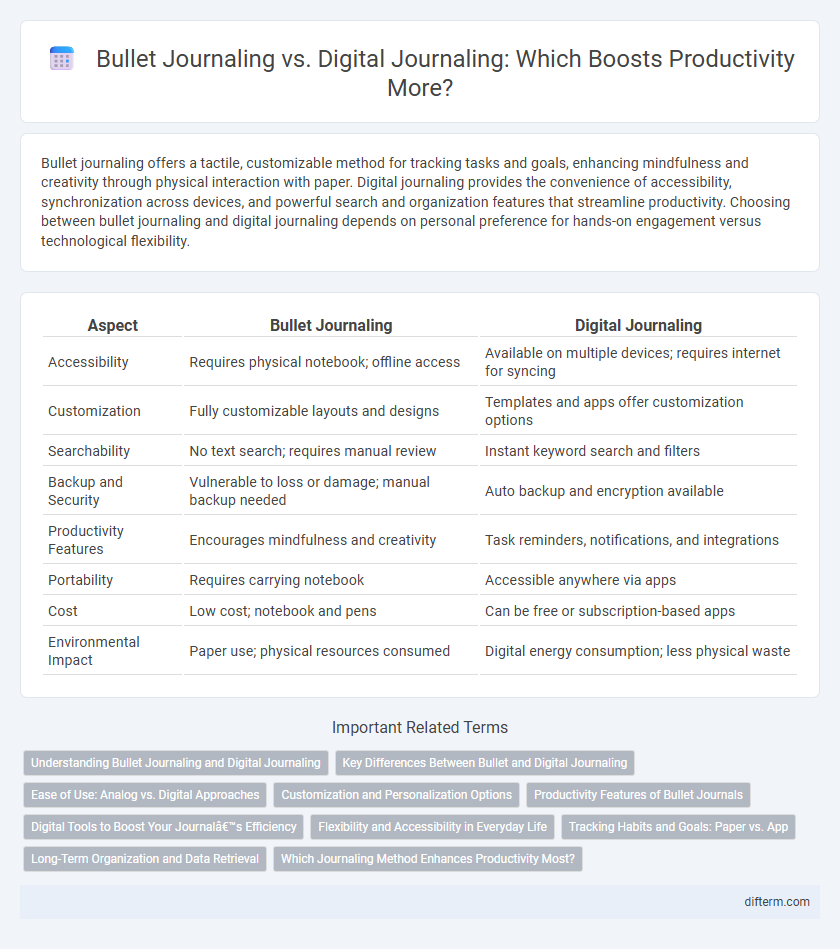Bullet journaling offers a tactile, customizable method for tracking tasks and goals, enhancing mindfulness and creativity through physical interaction with paper. Digital journaling provides the convenience of accessibility, synchronization across devices, and powerful search and organization features that streamline productivity. Choosing between bullet journaling and digital journaling depends on personal preference for hands-on engagement versus technological flexibility.
Table of Comparison
| Aspect | Bullet Journaling | Digital Journaling |
|---|---|---|
| Accessibility | Requires physical notebook; offline access | Available on multiple devices; requires internet for syncing |
| Customization | Fully customizable layouts and designs | Templates and apps offer customization options |
| Searchability | No text search; requires manual review | Instant keyword search and filters |
| Backup and Security | Vulnerable to loss or damage; manual backup needed | Auto backup and encryption available |
| Productivity Features | Encourages mindfulness and creativity | Task reminders, notifications, and integrations |
| Portability | Requires carrying notebook | Accessible anywhere via apps |
| Cost | Low cost; notebook and pens | Can be free or subscription-based apps |
| Environmental Impact | Paper use; physical resources consumed | Digital energy consumption; less physical waste |
Understanding Bullet Journaling and Digital Journaling
Bullet journaling combines analog note-taking with customizable organization, emphasizing tasks, events, and reflections through symbols and rapid logging, which enhances mindfulness and personalized productivity. Digital journaling offers versatile tools such as cloud synchronization, multimedia integration, and advanced search functions that streamline data retrieval and adaptability across devices. Both methods address productivity by encouraging structured planning and self-reflection, catering to different preferences for tactile engagement versus technological convenience.
Key Differences Between Bullet and Digital Journaling
Bullet journaling offers tactile interaction with paper, which can enhance memory retention and creativity through handwritten notes and customizable layouts. Digital journaling provides advantages such as easy editing, search functionality, and multimedia integration, making organization and retrieval of information more efficient. Both methods serve productivity but differ significantly in flexibility, accessibility, and sensory engagement.
Ease of Use: Analog vs. Digital Approaches
Bullet journaling offers tactile engagement and customizable layouts, allowing users to quickly jot down notes and track tasks without relying on technology. Digital journaling provides seamless integration with apps, automatic syncing, and search functionality, enhancing accessibility and organization across devices. Users prioritizing simplicity and minimal tools may prefer analog methods, while those valuing efficiency and data management often opt for digital solutions.
Customization and Personalization Options
Bullet journaling offers extensive customization with hand-drawn layouts, flexible page designs, and personalized symbols, allowing users to tailor their productivity system to unique preferences. Digital journaling provides advanced personalization through customizable templates, color coding, integration with apps, and multimedia embedding, enhancing organization and accessibility. Both methods support individual productivity needs, but digital journaling excels in automation and data synchronization across devices.
Productivity Features of Bullet Journals
Bullet journaling enhances productivity through customizable layouts that integrate task organization, goal tracking, and habit monitoring in one physical notebook, reducing digital distractions. Its rapid logging system allows quick note-taking and prioritization, fostering mindfulness and efficient time management. Unlike digital journaling, bullet journals leverage tactile interaction to boost memory retention and focus, supporting consistent productivity habits.
Digital Tools to Boost Your Journal’s Efficiency
Digital journaling leverages advanced tools such as cloud synchronization, multimedia embedding, and AI-powered search functions to significantly enhance productivity. Apps like Notion, Evernote, and OneNote offer customizable templates, real-time collaboration, and integrated task management, streamlining the journaling process. Utilizing reminders and cross-device access ensures consistent tracking and efficient organization, making digital journals highly adaptable to dynamic workflows.
Flexibility and Accessibility in Everyday Life
Bullet journaling offers unparalleled flexibility, allowing users to customize layouts and incorporate personalized symbols, which enhances creative expression and adapts easily to changing needs. Digital journaling excels in accessibility, providing instant syncing across multiple devices, search functions, and integration with calendars and apps for efficient time management. Both methods support productivity, but digital tools facilitate on-the-go updates, while bullet journaling fosters mindful reflection through tactile engagement.
Tracking Habits and Goals: Paper vs. App
Bullet journaling offers tactile engagement that enhances habit tracking through customizable layouts and visual cues, fostering mindfulness and routine reinforcement. Digital journaling apps provide automated reminders, progress analytics, and integration with other productivity tools, enabling efficient goal monitoring and data-driven adjustments. Both methods support habit and goal tracking effectively, but choice depends on preference for manual creativity or technological convenience.
Long-Term Organization and Data Retrieval
Bullet journaling offers tactile engagement and intuitive visual cues that enhance memory retention for long-term organization, while digital journaling provides powerful search functionalities and cloud synchronization for efficient data retrieval across devices. Digital tools enable tagging, indexing, and keyword searches that streamline locating specific entries, supporting ongoing productivity and project management. Combining analog methods with digital backups maximizes organizational flexibility and ensures durable access to important information over time.
Which Journaling Method Enhances Productivity Most?
Bullet journaling enhances productivity by promoting focused mindfulness and personalized organization through physical interaction with tasks, which helps reinforce memory retention. Digital journaling offers seamless integration with calendars, reminders, and cloud access, enabling efficient task management and accessibility across devices. Studies indicate that combining analog bullet journaling with digital tools may yield the highest productivity gains by balancing reflection with real-time task updates.
Bullet journaling vs Digital journaling Infographic

 difterm.com
difterm.com